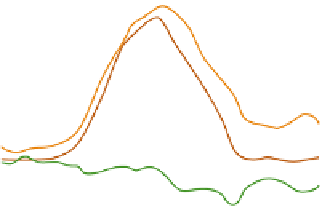Geoscience Reference
In-Depth Information
leaves. Tree size is obviously important. In
temperate forests the sizes may be closely similar,
whereas in tropical forests there may be great local
variety. Crown coverage determines the physical
obstruction presented by the canopy to radiation
exchange and airflow.
Different vertical structures in tropical rain-
forests and temperate forests can have important
microclimatic effects. In tropical forests the
average height of the taller trees is around
46-55m, with individuals rising to over 60m. The
dominant height of temperate forest trees is
generally up to 30m. Tropical forests possess a
great variety of species, seldom fewer than 40 per
hectare (100 hectares = 1km
2
) and sometimes over
100, compared with fewer than 25 (occasionally
only one) tree species with a trunk diameter
greater than 10cm in Europe and North America.
Some British woodlands have almost continuous
canopy stratification, from low shrubs to the tops
of 36m beeches, whereas tropical forests are
strongly stratified with dense undergrowth, simple
trunks, and commonly two upper strata of foliage.
This stratification results in more complex
microclimates in tropical forests than in temperate
ones.
It is convenient to describe the climatic effects
of forest stands in terms of their modification of
energy transfers, the airflow, humidity environ-
ment and thermal environment.
(A)
Noon
R
n
= 671
LE
= 706
H
= 59
Sunset
R
n
= 21
LE
=150
H
= 150
Lower
atmosphere
Sudan grass
ca
no
py
Soil
G
= 24
G
= 21
(B)
LE
600
Rn
400
200
G
0
H
-100
10
05
10
15
20
00
Hour
Figure 12.10
Energy flows involved in the
diurnal energy balance of irrigated Sudan grass at
Tempe, Arizona, on 20 July 1962.
Source: After Sellers (1965). By permission of the University
of Chicago Press.
as in a rice paddy-field, the energy balance
components and thus the local climate take on
something of the character of water bodies (see B,
this chapter). In the afternoon and at night the
water becomes the most important heat source
and turbulent losses to the atmosphere are mainly
in the form of the latent heat.
Modification of energy transfers
Forest canopies significantly change the pattern
of incoming and outgoing radiation. The short-
wave reflectivity of forests depends partly on the
characteristics of the trees and their density.
Coniferous forests have albedos of about 8-14
percent, while values for deciduous woods range
between 12 and 18 percent, increasing as the
canopy becomes more open. Values for semi-arid
savanna and scrub woodland are much higher.
Besides reflecting energy, the forest canopy
traps energy. Measurements made in summer in
a 30-year-old oak stand in the Voronezh district
of Russia indicate that 5.5 percent of the net
2 Forests
The vertical structure of a forest, which depends
on the species composition, the ecological
associations and the age of the stand, largely
determines the forest microclimate. The climatic
influence of a forest can be explained in terms of
the geometry of the forest, including morpho-
logical characteristics, size, cover, age and strati-
fication. Morphological characteristics include
amount of branching (bifurcation), the period-
icity of growth (i.e., evergreen or deciduous),
together with the size, density and texture of the
















































